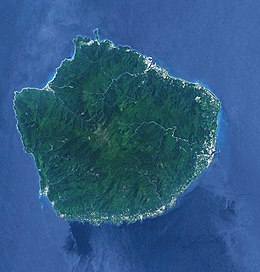Yakushima Island
| Native name: Japanese: 屋久島 | |
|---|---|

Landsat image of Yakushima
|
|
|
Location in Japan (with southern islands in inset)
|
|
| Geography | |
| Location | East China Sea |
| Coordinates | 30°21′31″N 130°31′43″E / 30.35861°N 130.52861°ECoordinates: 30°21′31″N 130°31′43″E / 30.35861°N 130.52861°E |
| Archipelago | Osumi Islands |
| Area | 504.88 km2 (194.94 sq mi) |
| Highest elevation | 1,935 m (6,348 ft) |
| Highest point | Miyanouradake |
| Administration | |
|
Japan
|
|
| Kagoshima Prefecture | |
| Demographics | |
| Population | 13,178 (2010) |
| Pop. density | 26.1 /km2 (67.6 /sq mi) |
| Ethnic groups | Japanese |
| Type | Natural |
| Criteria | vii, ix |
| Designated | 1993 (17th session) |
| Reference no. | 662 |
| State Party | Japan |
| Region | Asia-Pacific |
Yakushima (屋久島?) is one of the Ōsumi Islands belonging to Kagoshima Prefecture, Japan. The island, 504.88 km² in area, has a population of 13,178. Access to the island is by hydrofoil ferry (7 or 8 times a day from Kagoshima, depending on the season), slow car ferry (once or twice a day from Kagoshima), or by air to Yakushima Airport (3 to 5 times daily from Kagoshima, once daily from Fukuoka and once daily from Osaka). Administratively, the whole island is the town of Yakushima. The town also serves neighbouring Kuchinoerabujima. The majority of the island is within the borders of the Kirishima-Yaku National Park.
Yakushima's electricity is more than 50% hydroelectric, and surplus power has been used to produce hydrogen gas in an experiment by Kagoshima University. The island has been a test site for Honda's hydrogen fuel cell vehicle research. (There are no hydrogen cars stationed on the island but electric cars are run by the municipality.)
In 1980 an area of 18,958 ha was designated a UNESCO Man and the Biosphere Reserve. In 1993, 10 hectares of wetland at Nagata-hama was designated a Ramsar Site. It is the largest nesting ground for the endangered loggerhead sea turtle in the North Pacific. Yakushima's unique remnant of warm/temperate ancient forest has been a natural World Heritage Site since 1993. In the Wilderness core area (12.19 square kilometres (3,010 acres)) of the World Heritage Site, no record of past tree cutting can be traced. The island is visited by 300,000 tourists every year.
...
Wikipedia

